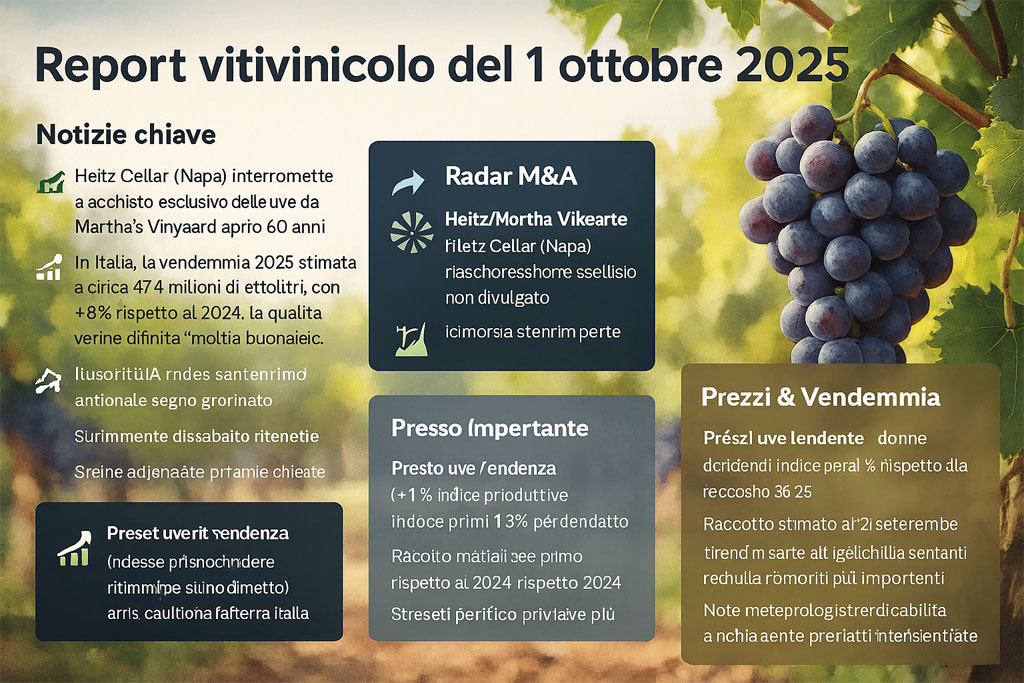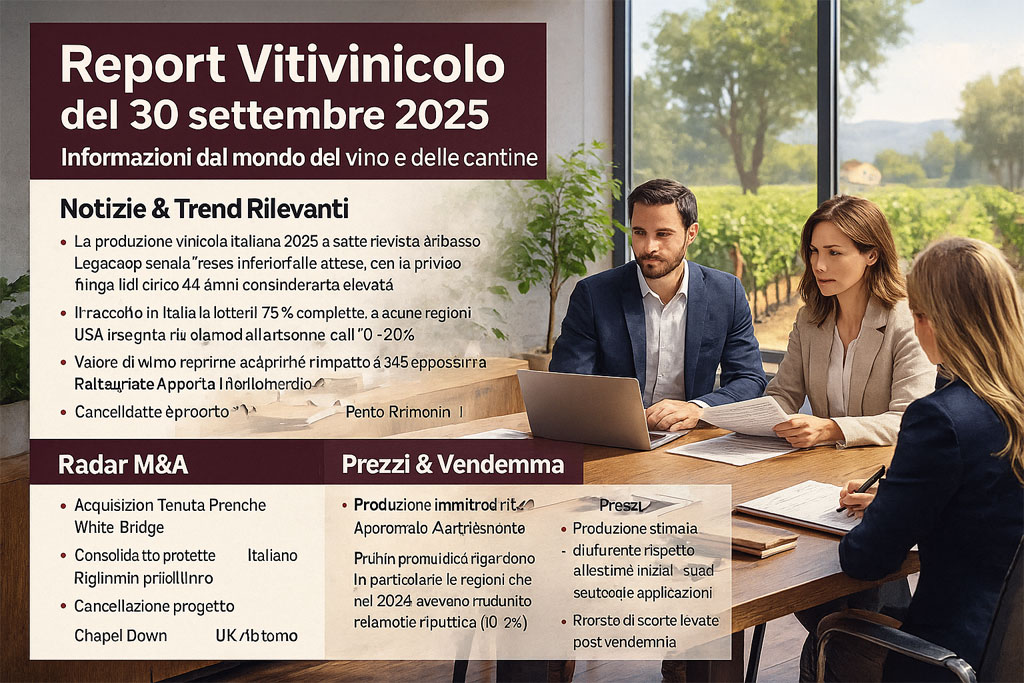The sector is in a “reorganization phase”: weak global demand for reds, US tariffs slowing purchases in Q2, inventories still high, but signs of stability in some markets (Canada, Germany, Japan, Brazil) and volume leadership confirmed in the USA.
Prosecco is the undisputed star. Domestically, consumer confidence is slightly up; more inclusive pricing policies are needed in the Ho.Re.Ca. channel to attract Gen Z and new wine consumers.

Wine Trends in Italy Week 29 September – 3 October 2025
Executive summary
Strategic priorities: export diversification, selective premium repositioning, inventory management, anti-counterfeiting traceability, and a push for data-driven “family” wine tourism.
Exports first semester 2025 (source Nomisma: monitored markets)
- USA : leading market but pre-tariff “pre-stocking” halted → from 22% (Jan–Mar) to -7% (Apr–Jun) . Italy: 2.5% in the first half thanks to Q1. Court of Appeals decision on legitimacy of tariffs pending.
- Canada : 11% imports from Italy; strong substitution of US wines on the shelves ( –65% ).
- Germany : 10.3% in value (still and sparkling goods: 14.2% ).
- Japan and Brazil : positive performances.
- United Kingdom : –7% in value ; sparkling wines –6.6% , still/sparkling wines –8.1% .
- Others in decline : Switzerland, South Korea, Norway, China ( -10.5% for still/sparkling wines).
- Italian sparkling wines (12 markets): growth slowed to 1% value / 6% vol ; dynamic Japan, USA, China . Weak UK, France, Australia .
Production, inventory and structure
- Supply chain: 30,000 processing companies (1,800 industrial), 250,000 agricultural; turnover €16 billion (excluding related industries), 2024 exports €8.1 billion , 74,000 employees.
- Italy: world’s leading producer (average 47 million hl ), leading exporter by volume ( >22 million hl ).
- Production volatility: peak 55 million hl (2018) ; minimum 38 million hl (2023) ; 2024 rising but below average; 2025 UIV estimate: 47.4 million hl ( 8% on 2024).
- Inventories : 2023 > production; July 2024: 40 million hl (–20% y/y with production –23%); 30 June 2025: 43.6 million hl (0.3% y/y; –6.4% on May), 2.7 million hl must and 63,926 hl new wine .
- Areas : Italy 728k ha (0.8%) ; national structural decline –15% (2000–2023) . EU27 3.2 million ha ; Spain 930k ha (–15%) , France 783k ha (–0.7%) ; China 753k ha (–0.4%) ; India growing 185k ha , CAGR 4.5% (from 2019) .
Prices, US tariffs and their impact
- Average export price (still in bottles): Italy €4.43/l , below France €7.81 , Australia €5.56 , New Zealand €5.86 .
- USA : worth ~ €2 billion (24% of Italy’s export value). Average tariff 2.9% until Jan 2025 → 15% from Apr 2025 .
- Estimated UIV impact : €317 million (up to €460 million with a weaker USD). Final markup from origination: estimated from 123% to 186% .
- Apr 2025 : Italy → USA –7.5% vol / –9.2% val . Jun 2025 : Italy €169.8 m (–4.2% m/m vs Jun ’24) ; France €191.3 million (5.9%) .
- Volume leadership confirmed: June 2025 Italy ~33 million liters (3.5%) = 32.6% of US imports; H1 2025 Italy 188.9 million liters (7.5%) > France (20.1% vol).
Focus Prosecco (UIV–Vinitaly / IWSR / SipSource)
- In the USA it is worth 31% of the value of Italian wine consumption ( $531 million in 2024 ).
- Awareness 40% (vs Champagne 52% ), but conversion to purchase 31% (Champagne 24% ).
- Sparkling wine share in the US (first 7 months of 2025): Prosecco 30% , Champagne 28% .
- Drivers: average price < $18 , strong penetration among women and Gen Z , use in mixology/RTD .
- Challenge: Growth in multi-ethnic communities (competitor: cocktails, hard seltzer, RTD).
Domestic demand and confidence (ISTAT, September 2025)
- Consumers : index from 96.2 → 96.8 ; economic climate 97.0 → 98.8 ; current 99.2 → 99.9 ; future 92.2 → 92.6 ; personal ≈96.0 .
- Businesses : 93.6 → 93.7 (stable); construction 101.3 → 101.5 , services 95.1 → 95.6 ; manufacturing stable 87.3 ; retail 102.7 → 101.6 .
- Wine implications: propensity for durable goods purchases slightly improved, but retail suffers; need to push by-the-glass , experiences, and entry-level pricing.
Ho.Re.Ca channel and distribution (Partesa interview)
- Excessive markups on entry-level labels are driving young people away.
- Virtuous model: wine by the glass with pouring technology, minimum quantities and continuity of supply, expansion of Italian labels.
- In 2025 price lists: avoid both drastic increases and decreases; focus on fresh whites and “pure” appellations with high quality/price ratios (Verdicchio, Garganega, Sangiovese, Chianti, Morellino).
Wine tourism and territorial branding
- International attraction for family-run wineries is growing: intention to visit on next trips → USA 78% , UK 74% , Germany 61% .
- Preference for family-run businesses : USA 68% , UK 57% , DE 49% ; very strong interest from Gen Z USA (82%) .
- Priorities: digital communication , multichannel promotion , AI to design experiences and manage flows. Key role: specialized consultant for omnichannel positioning and sales.
Policy, risks and operational proposals
- Safeguard Package (Eurispes): revision of Consolidated Law 238/2016 , yields/specifications/controls more in line with demand; labeling with ingredients and nutrition information ; simplification of inspections.
- Multi-level anti-counterfeiting : serial QR , RFID , NFC anti-tamper ; testing of new fiscal stamps started from 28 July 2025 .
- End-to-end AI : precision viticulture, winery (controlled fermentations, blends), marketing and CX.
- Plant authorizations : 1-year suspension of fines for non-use before January 2025; extension of replanting period to 8 years .
- Insurance/guarantees : evaluate an export coverage scheme similar to Cap Francexport; yield mutualization fund to stabilize prices (avoid sell-offs, dispose of surpluses, including through juice/distillation).
- US Tariffs : USWTA mobilizes industry with survey for economic evidence; leverage for negotiating pressure.
- Uprooting : German pan-European plan proposed (based on the 2009–2011 model); Italy more cautious → preference for reconversions and active vineyard management.
Opportunity to be seized immediately
- Rebalance export portfolio : boost Canada, Germany, Japan, and Brazil ; monitor the UK and China with targeted plans.
- Selective premium : communicating value (territory, sustainability, winemaking precision) to close the €-/l gap with the French.
- Prosecco : defend US share (mixology, RTD, non-Caucasian communities, West & East North Central).
- Family-friendly wine tourism : packages bookable online, transparent pricing, CRM and AI-driven UGC content.
- Ho.Re.Ca : inclusive price lists, by-the-glass , menus under €20–25 for quality entry-level options.
- Supply/Inventories : harvest-sales plans, cuvée segmentation, alternative channels for surpluses.
- Trust & Anti-Fake : Progressive rollout of QR-RFID-NFC new tags; storytelling on product security.
Final route note
2025 is the year for “active selection”: less product dispersion, more focus on markets and channels that boost margins and reputation, with Prosecco as the battering ram, wine tourism as the catalyst, and the digital/AI supply chain as the neural network. This is where the competitive advantage for the next 24 months will be built.




